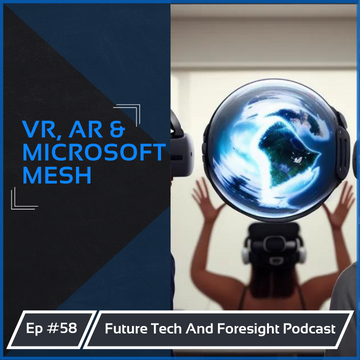About The Episode
As with some previous episodes that have focused on specific tech releases or recent news events dealing with emerging tech, today we will be looking at the recently announced platform from Microsoft.
Earlier this month Microsoft announced Microsoft Mesh, the new mixed-reality platform that allows people in different physical locations to join collaborative and shared holographic experiences on many kinds of devices.
Transcript
Earlier this month Microsoft announced Microsoft Mesh, the new mixed-reality platform that allows people in different physical locations to join collaborative and shared holographic experiences on many kinds of devices.
For those wondering, this is not Hololens. Hololens is the mixed reality headset that has the smartglasses which allow you to see the digital items or holograms on a normal analog environment. Mesh on the other hand is the platform that will enable collaborative experiences in mixed reality by using Hololens, but also with a range of virtual reality headsets, smartphones, tablets and PCs. Think of a new sports car design team, spread across different parts of the world, all putting on a hololens2 device, and working on the new vehicle design. By using the headsets, they can all see the digital design of the car in front of them in their own living rooms, but with Mesh, they would also be able to see each other, this is the exciting difference.
Intro trailer: https://www.youtube.com/watch?v=Jd2GK0qDtRg
Microsoft hopes Mesh will be seen less as a virtual reality platform and more as a virtual meeting platform, an extension of Microsoft Teams that would replace a physical conference room.
This is important because Microsoft Teams has been one of the dominant office suite platforms used by businesses, more and more as Covid has forced us all to work remotely.
Holoportation?
The first step will be using digital avatars, the ones we see being used in Virtual Reality experiences to portray us in the mixed reality space. However, the ultimate goal is something called Holoportation. This was first presented back in 2016 by Microsoft and is where the unique selling point of Mesh truly is.
3D capture technology will beam a lifelike digital image of a person into a real environment. This is different from the digital avatars we all experience in virtual reality. It is a true digital self, or a photorealistic self-representation, complete with real time facial expressions, and full body movements. Though of course even in the introduction video the quality and clarity of those digital selves is still not to the standards of what we see in sci fi films today, eventually the hope is to get there.
Alex Kipman, the Technical Fellow for AI and Mixed Reality in the Cloud and AI Group at Microsoft had this to say about it:
“This has been the dream for mixed reality, the idea from the very beginning […] You can actually feel like you’re in the same place with someone sharing content or you can teleport from different mixed reality devices and be present with people even when you’re not physically together.”
We are all tired of zoom meetings – this can offer the human connection that zoom doesn’t offer, and which we are missing in our social distancing and remote era.
As a VR enthusiast, this has been perhaps the most exciting thing about VR in our Covid era, the ability to have an immersive and engaging experience with colleagues, friends, or family, while being in different locations. Especially when it comes to the business world, where collaboration is key to many projects and organisations, this might provide part of the solution for remote teams.
One of the obvious benefits when compared to VR is that you don’t necessarily need a dedicated part of your apartment or house to use it. With VR, depending on your headset you are mostly confined to a specific open area but still have the risk of knocking into things while you are fully immersed in the digital space. With Mesh, as with any AR headset, the digital environment is overlaid onto your real, analog space, which avoids this issue entirely.
But these benefits also lead to some potential pitfalls of the technology
Potential drawbacks
The first and most obvious is how exactly are we going to be scanning ourselves into this mixed reality space to enable “holoportation?” Mesh is just a platform, it does not offer a new hardware product that can make that required digital scan. To make holoportation work in the early demos an elaborate and expensive camera setup was required. I can see that similar Virtual Reality digital avatars will be the main use for some time.
Though it’s possible that the unconscious interaction with avatars and “holoporting” colleagues and friends will alleviate Zoom fatigue, the catch-all term for the exhaustion some feel after a day’s worth of videoconferencing. It’s equally possible that you’ll end up with a headache, cramped neck, or other issues after wearing a headset for hours on end.
Lastly but certainly not less relevant is cost. Though Mesh will work on a range of headsets, tablets, and mobile phones, it seems that the best way to use it is with the hololens2…which goes for upwards of 3000$. 10x more than the oculus quest which has VR options for collaborative meetings and events.
Final thoughts
The potential social impact of such a functional platform is something straight out of sci-fi. The social opportunity is compounded by the fact that you would be able to explore the actual world with holoported friends. We saw with the explosion of Pokemon Go back in 2016, that various and new social ramifications came about due to the AR game. This included: increased screen and internet use, traffic accidents, and even abductions. But also triggered curiosity, an increased excitement of exploration, more time outside, and social bonding between players. With Microsoft Mesh’s desire to have a more immersive experience where you’d ultimately be able to bring virtual friends along as you go out and walk, explore the world, and simply live, these social impacts will potentially be compounded both for the better and for the worse.











